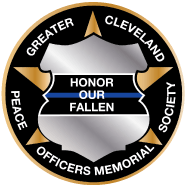END OF WATCH: March 9, 1919
Cleveland Police Department
Patrolman William P. Armstrong, was appointed to the Cleveland Police Department on June 20, 1915. He was a graduate of South High School and his education prompted police authorities to urge him to work in the office. Patrolman Armstrong felt the office work was not exciting enough.
Patrolman Armstrong was assigned the beat of Patrolman William Brown, who was shot and killed September 25, 1917, while making an arrest.
On March 9, 1919 Armstrong observed a black man robbing Wilson Dilsaver at gunpoint. When he approached the gunman, the gunman suddenly turned and fired two shots striking him in the upper chest. One of the bullets passed through his body near his heart.
Even though Armstrong lay mortally wounded in front of the County Morgue, he was able to unholster his revolver and fire two shots at the assailant as he fled. The assailant made his escape and his identity was not established. Officer Armstrong was taken to Lakeside Hospital where he died a few hours later.
Armstrong’s death was the end of a Saturday night wave of crime. Prompted by Armstrong’s death, Chief Smith urged passage of legislation that would permit police to search homes of persons with doubtful reputations who might conceal fire arms or other weapons. Such a law would decrease the carry of concealed weapons at least by 90%.
Criminal investigation revealed a revolver holster was found near the spot where Armstrong was mortally wounded, this fact was expected to aid police in finding their comrade’s murderer. Ten people were arrested in connection with the shooting, eight were released and the other two were held as witnesses.
On March 10th a number of uniformed patrolmen were put on plain clothes duty and joined members of the Detective Bureau to place a dragnet the City to search for the slayer.
A suspect was arrested in June of 1922 based on a statement of his girlfriend that he told her of the crime. Robert Brown of St. Louis was interviewed by Detectives and the statement was found to be false. Over the years, information was compiled that Earl Boyd, a black male, was responsible for the murder. In 1930, Boyd was arrested in Chicago, Illinois. Investigators went to Chicago and checked out Boyd’s activities, especially those actions while in the Cleveland area, but decided not to extradite him.
William Perry Armstrong, beloved husband of Lillian (nee Fenohr), father of William Perry, Jr., son of Martin and Minnie Armstrong, and brother of Lyle and John was laid to rest on March 12, 1919 at 2 p.m. at Woodland Cemetery.
William Perry Armstrong’s name is inscribed on the National Law Enforcement Officers Memorial Wall, Washington, D.C., panel 37, west wall, line 1.
By Recruit Shawn P. Graham, Cleveland Police Academy

